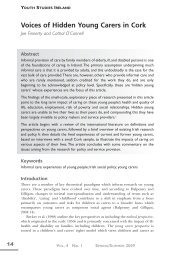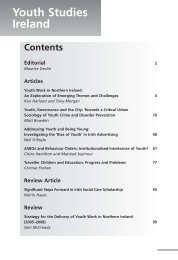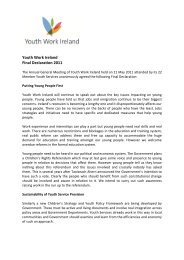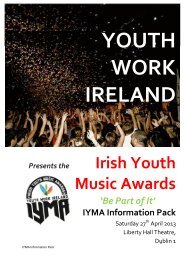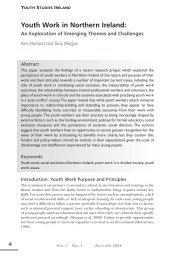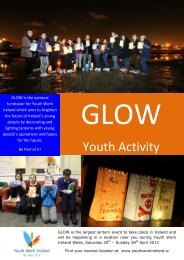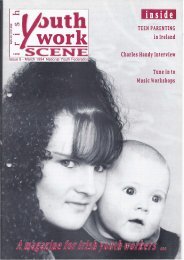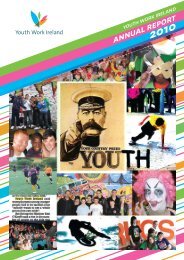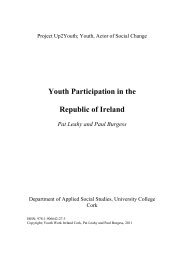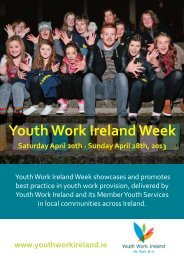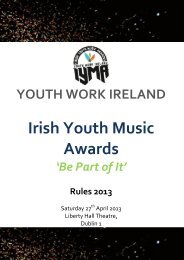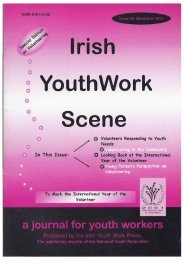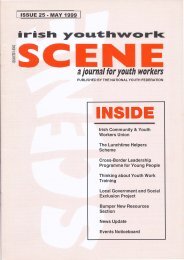Issue 31: March 2001 - Youth Work Ireland
Issue 31: March 2001 - Youth Work Ireland
Issue 31: March 2001 - Youth Work Ireland
Create successful ePaper yourself
Turn your PDF publications into a flip-book with our unique Google optimized e-Paper software.
Abuse, Harassment and ViolenceHidden Life of Irish Teensby Women's Ai dIrish teenagers have high levels of contact withviolence, abuse and harassment according to"Teenage Tolerance", research launched on 14February by Minister of State in the Department ofEducation and Science, Willie O'Dea TD, in DublinCastle on behalf of Women's Aid.A poster campaign entitled "Tell Someone" was alsolaunched today by B*Witched to encourage youngpeople to contact Women's Aid or the Rape CrisisHelplines. The poster will hang in schools and youthclubs.The research was conducted with over 300 youngmen and women between the ages of 14 and 19, infour Dublin schools and one senior college. Theresearch was conducted through questionnaires andfocus groups by Women's Aid and the Child andWomen Abuse Studies Unit, London University.Women's Aid is a voluntary organisation which, forover 25 years, has provided services to women andtheir children who are experiencing violence in thehome. Women's Aid has delivered preventativeeducation work in the education and youth sector forthe last seven years. This study was funded by theEuropean Commission and the Department ofEducation and Science.95% of young women and 84% of young menreported knowing someone who had experiencedabuse, violence and harassment ranging fromfollowed, to being forced to have sex, to being hit bya partner. The persons known were mainly youngwomen.I in 4 young women knew someone who was forcedto have sex, with over 76% of those known beingfriends. The research also indicates that youngpeople are not reporting their experiences toparents, teachers or other adults, but instead arejust telling their friends.According to Denise Charlton, Director of Women'sAid:"The findings of this research are not just alarming,they also indicate how, as a society, we are failingour young people.education,With limited sex and lifeskil/sand few support systems for youngpeople, we are leaving young people to cope withthese issues alone or with each other."The report also highlights confusion amongst youngpeople about the meaning of rape, violence, andconsent. 19% of young women and 34% of youngmen did not think being forced to have sex is rape.The report also indicated that there is a high level ofexposure to pornography, particularly amongstyoung men. Of the 94% of young men, who hadcontact with pornography, 3 out of 4 accessedpornography on the Internet, mainly on homecomputers or friends' computers.The report also indicates that while both young menarid women are sexually active, a double standardstill exists in relation to sexual activity, withreputation clearly affecting young women in anegative way, whilst young men's reputation isenhanced amongst their peers by sexual activity.Both young men and young women fear physicalattack in public places such as the street, nightclubsand bars, however young women also fear sexualassault and being drug raped.Teenage Tolerance - Women's AidDefining Rape1 There is an alarming degree of confusion amongstyoung people. Whilst the vast majority of youngpeople viewed being forced to have sex as rape,19% of young women and 34% of young men didnot, For some young people, force alone was notenough, it must be force plus - plus additionalviolence, plus being held down - It appears thatyoung people are distinguishing between types ofrapeContact with and Attitudes to Pornography1 94% of young men and 68% of young women hadIrish <strong>Youth</strong><strong>Work</strong> Scene J <strong>March</strong> <strong>2001</strong>
seen pornography.• Of those who had seen pornography, 3 out of 4young men had accessed Internet porn, comparedto I in 3 young women. Home computers are themost common access point, with almost half (48%)using their own and a third (33%) using friends.• 49% of young men and <strong>31</strong> % of young womenreported that pornography made them feel betterabout sex as they learnt about it and it helped theirperformance. However, 1 in 5 (20%) reportednegative impacts and felt it was degrading andexploitative.Safe and Unsafe Sex• 1 in 5 young people (19%) admitted having sexwhen drunk (drugged, and focus group discussionshowed that there is a sexual culture where drinkand drugs are seen both as an excuse to have sex,as well as to eschew responsibility for oneself andothers. Getting /being drunk clearly interfered withyoung men and young women's clarity about themeaning of consent.1 Having sex when drunk/drugged left the largestgroup of young men feeling that it was ok andnormal whereas the largest group of young womenreported feeling dirty/horrible, something no youngmen reported feeling.• 17% of young people reported that they had hadunprotected sex.Double Standards• 50% of young people believe there is still a doublestandard between boys and girls regarding sex, with56% of young people saying that girls are calledsluts or thought less of, if they have multiplepartners, and 55% saying that boys get respect formultiple partners.Personal Safety and Place• 55% expressed concerns about safety in the street- of this group, 37% concerned about physical attack29% about street crime, and 25% about sexualattack (this group comprised almost completely offemales). Being stalked kidnapped and followedwere also concerns articulated by young women.1 46% had concerns for safety in discos/clubs/pubs.Here, fear of physical attack and fear of rape as aresult of being drugged, and of sexual assault ingeneral stood out. The fear of physical attack wasshared by both groups, although felt somewhat morestrongly by young men, but fears about sexualassaults were overwhelmingly expressed by youngwomen.1 Almost 1 in 5( 19%) reported concerns about theirIrish <strong>Youth</strong><strong>Work</strong> Scenesafety in relationships, with 1 in 4 young womenexpressing concern, and 1 in 8 young men. Genderdifferences are further amplified when the preciseconcerns are examined. For young men, it isprimarily sexually transmitted diseases andpregnancy, whilst young women also fearpregnancy, but twice as many feared beingused/abused, and a few explicitly referred to fears ofrape.• Young women expressed more concerns for theirpersonal safety, and much of their anxiety revolvedaround forms of interpersonal abuse: a significantminority were explicit about their fears of rape andsexual assault, harassment or being abused withinrelationships.IsKnowledge of Abuse of Others su1 Being followed, flashed at, subjected to nasty Esexual comments, pressured to have sex, forced tohave sex, being sexually assaulted, hit by a partner,injured by a partner, being in fear of a partner, beingcontrolled by a partner.• 95% of young women and 84% of young menreported knowing someone who had experiencedone of the specific forms of harassment. 68% ofwomen and 47% of men reported knowing someonein at least 4 categories, while 5% of femalesreported they knew someone who had experiencedall 10 experiences. The person known wasoverwhelmingly female.• 1 in 4 young women reported knowing someonewho was forced to have sex, with the majorityreporting that it had happened to a peer.• 46% reported knowing someone who was hit by apartner (56% of females, <strong>31</strong> % of males) whilst halfwere peers, 8% reported their parents being hit by aparent. The perpetrator was overwhelmingly male(92%).• 53% of young people reported that they had beentold of this experience by another (65% of youngwomen, 36% young men). Very few young peoplereported either seeking assistance from others (3%)or confronting the perpetrator ( 1 % ).• All of the young people found providing support Idifficult, with the most common problems beingShearing upsetting accounts and uncertainty aboutSwhat action to take.uYoung People's Own Experiences Of AbuseEs• Being followed, flashed at, subjected to nastysexual comments, pressured to have sex, beingforced to have sex, being sexually assaulted, hit bya partner, injured by a partner, being in fear of apartner.• 81% of young women and 54% of young men<strong>March</strong> <strong>2001</strong>IssuEssIssuEs
eported having experienced at least one of thespecific forms of harassment/abuse, 2 out of 3young women and 2 out of every 5 young menreported having had more than one experience.1 1 in 3 young people bad been followed flashed atand/or had nasty sexual comments directed at them.Most of these incidents had occurred duringadolescence with the majority of perpetrators beingmale.1 Being pressured to have sex was reported by 15%of the young people, whilst being forced to have sex(5%) and being sexually assaulted (6%) wasreported by a minority.1 Young women reported far more incidents ofadolescent non-consensual sex and sexual assault.The majority of perpetrators were over 18 andknown to them1 7% of young people reported being hit by a partner(8% of young women, 6% of young men), but1 in 8 young women reported being controlled by apartner compared to 1 in 20 young men.1 Overwhelmingly, when young people toldsomeone about their experience, it was a friend thatthey told.1 Violence and Abuse are a large part of youngpeople's lives, either through personal experience orknowing someone. Vast majority support each otherand do not look outside themselves for help.Support Needs of Young People1 60% of young people would use "adult" supportservices as they see them as being confidential anda way of accessing advice and information.1 78% of young people want issues covered by thisresearch discussed in schools, although over halfwant this done by outsiders.1 Young people are an important source of supportto each other, however many expressed concern atthe limits on them to do anything which requiredmore than this.1 Young people have high levels of contact withharassment, abuse and violence - many youngpeople know of someone In theirfamily/friendships/community groups who hassuffered harassment, abuse or violence.2. Young people demonstrated a lack of clarity aboutdefinitions of rape, assault and harassment.3. Young men and women demonstrated differingviews about double standards consent and how toyes and no to sex.4. Young people had high levels of exposure topornography and a majority of young women havingsome contact with pornography.Irish <strong>Youth</strong><strong>Work</strong> Scene 55. Young people had difficulty disclosing theirexperience of violence, harassment and abuse dueto lack of appropriate support structures andservices including life skills education.RecommendationsWomen's Aid as a result of the information gainedthrough their provision of services and researchstudy recommend the following:Services1 Funding for design and production of specificallytargeted and appropriate promotional materialswhich will encourage young people to considerexisting helplines.1 The development of further support servicestargeted at young people, e.g. protection andintervention services, one-to-one and outreachservices.Awareness and Training1 A public awareness campaign providinginformation and awareness materials and mediaactivity in relation to violence and abuse directedspecifically at young people.1 A public awareness campaign in relation to theaccessibility and impact of pornography, in particularin the home, via the Internet.1 Training for teachers, youth workers and serviceproviders in relation to disclosure and referral in thecase of violence and abuse.Prevention1 A mainstreamed prevention education programmedelivered by appropriate services. The programmeis a response to the necessity for education work, inrelation to violence and abuse and should includesessions on lifeskills, awareness, strategies tochange and challenge and to provide support andinformation. External service providers in responseto young people's requests as voices in thisresearch would deliver the programme.For more information, please contact:Teresa O'Donnell or Rosie McGlone,Women's Aidat 01 874 5302 or 087 919 2457,orDenise Charlton at 087 243 8603<strong>March</strong> <strong>2001</strong>IssuEsIssuEsIssuEsIssuEsIssuEsIssuEs
Policing the Will of the Gardai to ImplementGarda Clearanceby C. N iall McElweeIntroductionThis article seeks to explore the issue of students onthird level Social Care courses (Child and <strong>Youth</strong>Care) attempting to obtain clearance from the Irishpolice (Garda Siochana) to work with vulnerablechildren and young people. It argues that the Gardaiwill need to be more proactive than has been thecase heretofore and that Social Care students andpractitioners must continue to politicise this issue if itis to be resolved. It appears as if the issue of thirdlevelstudent police clearance just will not go away.At present, the Gardai are not obliged to providestudents of Social Care with clearance whilst theyare studying for their Certificates, Diplomas andDegrees. This has led to an unhappy situationbetween the third level providers of education andtraining and some social care agencies wherestudents might ordinarily locate practicumexperience.The Irish Association of Social Care Educators iscollectively pursuing the issue of obtaining Gardaclearance.O Mildred Fox, TD for Wicklow, maderepresentations to the Minister for Justice in April2000 after a formal communication on the matter bythe aforementioned IASCE.2for change across a number of areas such astraining, qualifications, registration and professionalstatus (McElwee, 2000).The Director of one prominent residential social careagency providing care for young offenders hasrecently written to the Heads of Courses in theInstitute of Technology sector advising them of hisconcerns in an era of increasing understanding ofchild sexual abuse.3 Specifically, he has raised theissue of 'unsuitable' people gaining access tovulnerable children. In his circular to the Heads ofSocial Studies, the Director comments:As you are aware, paedophiles and otherperpetrators of sexual, physical and emotionalabuse on children are often extremely articulate andplausible individuals who are often exceptionallydifficult to identify even with a fill criminal recordcheck' (Keating, 2000).Of course, Keating is not the first professional toraise such concerns. One has only to rememberback to the influential Kennedy Report (1970) andthe later Task Force on Child Care Services (1980)to witness such concerns in the field. Nonetheless,this is an important and timely topic for considerationas Keating is the first Director of a social care centreto formally pursue this matter with the IrishAssociation of Social Care Educators. I anticipatemany more joining in the call in the near future.The New Landscape of Social CareProvisionThe 1991 Child Care Act in this country has createda new working landscape for child protection andwelfare and the police have been given a central roleas advocates in the arena of child protection andwelfare in addition to their more traditional role of lawenforcers. The public is now more enlightened withThe (Initial) Response of the PoliceThe Irish Association of Social Care Educatorscontacted Garda Headquarters in Dublin in January2000 outlining its concerns as educators of socialcare practitioners.The Association was informed that:regard to child abuse and neglect and child (a) Garda clearance is only processed forprotection and welfare and is less willing than in thepast to simply allow the situation to remain health boards.unchanged.prospective full time health care workers of the(b) The matter was being discussed with the GarciaThe practice organisations (Irish Association of Care Commissioner with a view to responding to the<strong>Work</strong>ers and Resident Managers' Association) have increasing number of applications made to thealso lobbied the relevant government departmentsGardai from a wide variety of agencies.Irish <strong>Youth</strong><strong>Work</strong> Scene 6 <strong>March</strong> <strong>2001</strong>
(c) A concern was expressed that some agenciesmight place too much emphasis on the Gardaclearance as a means of vetting employers.References might not be chased up adequately.(d) A further concern expressed was that anindividual could actually use Garda clearance tomasque his/her past.(e) The Commissioner foresees the establishmentof new office with the express responsibility ofprocessing Garda clearance requests (IASCE,2000).3What is the Current Situation for the Policein the Irish Republic?From 1994, the police were obliged to carry outbackground checks 'in respect of full-timeprospective employees in the health care area whowould have substantial access to children orvulnerable young people' (O' Donaghue, 2000). Thisleaves students of social care courses in no-man'sland until either they graduate, or their student statusis recognised in itself. A number of potential legalproblems remain unresolved for students, collegesand employers such as what happens if a collegediscovers that a student has a criminal prosecutionin year two of a three year course or should thecolleges differentiate between prosecutions?Some colleagues feel that a drink driving offenceshould not count against a student's progress,whereas other colleagues feel that it should be takenmost seriously by a course board, as it might be anindication of weak moral character! The examplesone could provide are endless.A comprehensive review of police 'clearance'arrangements has now been undertaken and aninternal <strong>Work</strong>ing Group was established by theGardai to look into an effective response from thePolice that would prove mutually acceptable to all insocial care. The Garda Commissioner has alsoestablished an 'implementation group'. The latestsituation is that Garda Headquarters hasrecommended the establishment of a central vettingunit to process applications for Garda clearance, butit is unclear if applications by students going onplacement will be considered (McHugh, 2000).What Has Been Done?As with so many things in Irish life, an interimworking solution has been found. Students are beingadvised to apply for Garda clearance through theIrish <strong>Youth</strong><strong>Work</strong> SceneDATA Protection Act (1988) under section four. Theyare to give their frill names, current address, date ofbirth and a request fee of £5. In this manner, we canovercome the issue for the moment.The response from the D/Superintendent forAssistant Commissioner of the Gardai is interestingas seen from the following typical correspondencereturned to a student at the Waterford Institute ofTechnology where it is clearly stated that theconfirmation is not a letter of Garda Clearance.General Office, Security and IntelligenceBranch, Phoenix Park, Dublin 8.Strictly Private and ConfidentialThis document should not be construed as aPolice Certificate of Character, a GarciaMs XXXXXXAddress.Re:Act, 1988.Reference or Garcia Clearance.Request under Section 4 Data ProtectionI wish to refer to your request in the above matterand to inform you that a search of the GardaCriminal Records Database reveals no personaldata on you.The searches were carried out on the basis of theidentification particulars supplied to this office as peryour correspondence.I wish to acknowledge receipt of £5 request fee.Yours sincerely,D/Su perintendent for Assistant Commissioner.Should Police Clearance be the Role of thePolice?As with most organisations, the Gardai areoverstretched and under-resourced. This is also anew area for the Gardai to consider and moves themaway from their more traditional duties andobligations. Perhaps the vetting process could betterbe done with trained civil servants based in a Garda<strong>March</strong> <strong>2001</strong>c0MMENTc0MMENTc0MMENTc0MMENTc0MMENTc0MMENT
office than by active Gardai themselves. Perhaps anentirely separate agency should be created with aspecific remit in this area.These are not unreasonable views. But, it seems tome, that the Gardai are ideally positioned toundertake this task as they are now to the forefrontin child protection and welfare and are accumulatingincreasingly sophisticated ways of working withvulnerable populations.ConclusionAll of us involved in the field of child and youth caremust continue to exert pressure on politicians,relevant personnel in the Government Departmentsand the police to ensure that this issue does not fallto the bottom of an admittedly overworked agenda.Students must be rigorously assessed and, as withgraduate practitioners, monitored by the police andthe colleges to ensure that they do not obtain acriminal record that would make them unsuitable forwork with vulnerable populations.In the meantime, the Irish Association of Social CareEducators has insisted that each of our CYCstudents obtain some form of Garcia clearance bythe end of term one 2000 to protect both them, andus, (as educators) should an issue arise around theirlegal status to practice in social care. It isunfortunate that we have moved into the newMillennium without having obtained such basicprotection for vulnerable populations.ReferencesO' Donaghue, J. (2000). Communication to MildredFox, TD. 18.4.00Task Force Report on Child Care Services.(1980). Dublin: Government Publications.About the AuthorC. Niall McElwee has been lecturing andresearching in the field of social care for a decade.He is Director of Social Care Programmes at theWaterford Institute of Technology, Academic Coordinatorof the Centre for Social Care Research atthat college, founder and Editor of the Irish Journalof Applied Social Studies and is currently Presidentof the Irish Association of Social Care Educators. Heis the author of Children At Risk ( 1996) and To TravelHopefully. Views from the Managers of ResidentialChild Care Units in <strong>Ireland</strong> (2000).He is also co-author of a number of books includingProstitution in Waterford City: A ContemporaryAnalysis (1997), Irish Society: A Reader in AppliedSocial Studies (1997), Worthy Not Worthwhile:Choosing Careers in Caring Occupations (2000).His forthcoming textbook is titled Five Scenarios andSolutions for the Social Care Practitioner (<strong>2001</strong>). He Cis also a frequent media commentator in the area of 0social issues and has a consultancy practice based Min County Kilkenny.Footnotesc0MMENTc0MMENTc0MMENTMENTIrish Association of Social Care Educators.(2000).Internal Memorandum to members.Keating, T. (2000). Letter to Irish Association ofSocial Care Educators. 6.6.00.Kennedy Report. (1970). Dublin: Government of Parliament.1 The Irish Association of Social Care Educators wasestablished to advocate on behalf of educators,students and graduates in the field of child and youthcare.2 A TD is a member of Dail Eireann, the Irish HousePublications3 Seven Institutes of Technology (and St. Patrick'sMcElwee, C. N. (2000). To Travel Hopefully: Views College Carlow) provide third level training andfrom the Managers of Residential Child Care in education of social care practitioners/child and youth<strong>Ireland</strong>. Waterford: RMNCentre for Social Care care workers from Certificate to Diploma to DegreeResearch.level (with the exception of Carlow which ceasesprogrammes at Diploma level).McHugh, J. (2000). Personal Correspondence toAuthor.Irish <strong>Youth</strong><strong>Work</strong> Scene 8<strong>March</strong> <strong>2001</strong>c0MMENTc0ENT
A Picture of BallinasloeBy John LanganIntroductionThe Idea of running a photography course arose inApril 2000 while planning the summer programmefor young people in Ballinasloe. The count had twobroad aims, one to give young people a practicalskill and secondly to introduce them to the use ofphotography as a tool to explore people's lives.In July 2000. Galway <strong>Youth</strong> Federation securedfunding fur the project from The Arts Council throughthe Artist-in-Community Scheme. Eileen O'Leary ofKerry, Diocesan <strong>Youth</strong> Service, who has extensiveexperience of documentary photography, wascontacted and agreed to run the project.The project ran for one week culminating in anexhibition, which was held in the local library. Fouryoung men took part in the project. The commitmentthey made was enormous, attending each day andworking together for 7 hours daily. In order to havework to exhibit, the young men worked in pairs alongwith a staff member of Galway <strong>Youth</strong> Federation andthe local Department of Justice Project. The stafftook photographs of the young people completingtheir assignments.Project Weeka caption for each shot. The image number andcaption were recorded for later reference. In additionto learning how to edit their work each day, theyoung people were encouraged to critique their workand suggest where they could improve the quality ofthe images.On Thursday each participant selected his favouriteeight Images from the week. These were thenenlarged 10 by 8 and mounted on white card with acaption and the young persons name. A collage wasmade of the photos the staff had taken of the youngpeople during the week and each person had aportrait taken.On Friday members of the public attended theopening of the exhibition. A local photographer alsoattended to take some shots of the work. The youngpeople were on a high. They were really proud oftheir hard work, which had certainly paid off.All project participants were awarded introductorylevel and Intermediate level Certificates inPhotography from the Northern <strong>Ireland</strong> OpenCollege Network, One of the participants said at theend of the project, "/ had the best time ever withGeoff, John, Eileen. I will do it again next year".The work remained on exhibit in the library for twoweeks before moving to the Bank of <strong>Ireland</strong> for amonth. The work was also exhibited in the youngpeoples school.Over the course of the week the young peopledocumented life in Ballinasloe. The group also wentto Athlone to take some photographs of servicesavailable to young people so that we could make acomparison between both towns. As one participantsaid "The second day (of the project) we went toAthlone and we took pictures of the leisure complexand the swimming pool. There is nothing like this inour town. If there were facilities like this inBallinasloe there would be a lot less trouble in thetown''.Each day the young people shot an average of sixrolls of film each. At the start of each day the youngpeople selected their three favourite images fromeach roll. These were put in a scrapbook along withIrish <strong>Youth</strong><strong>Work</strong> Scene 9Due to the success of the summer photographyproject and inspired by the growing interest theyoung people had in photography, a follow-upproject was planned. This project involved aresidential shoot, which incorporated black andwhite photo development. Again we looked to EileenO'Leary to progress the work she had begun in thesummer with the young men.Three of the original participants (the fourth iscurrently living in England), one volunteer, RachaelWhite and I left Ballinasloe early on Friday morningDecember 8th. Our destination was Tralee and more<strong>March</strong> <strong>2001</strong>
importantly Eileen's Darkroom.We arrived at 1.00pm and after a quick cuppa wewere off to shoot some film. We went to Blennervllleand Fenit where we took photographs of the windmilland boats. Then it was back to the darkroom to startdeveloping.Our first job was to take the film oft its roll and put iton the processing reels. This was much moredifficult than it sounds - we were tired and the task istedious initially. The next step is to process the film.There are three steps involved in processing. Firstly,Developer is used, secondly Stop (which stops thedevelopment process) is used and finally Fix (whichfixes the image on the negative for the future).The film is then washed to remove any traces of thechemical, before it is hung up to dry. Unfortunately,the chemicals were somehow switched and at theend of the process only one of us had images on thenegatives.On Saturday we re-traced our stops to Blennervilleand Fenit, We also went to Killarney and toMuckross House. For one member, one of thehighlights was climbing 'the mountain to ToreWaterfall.Back in the darkroom, once we had some Images onour negatives, we continued to the next stage. Firstlywe made a contact sheet from which we selected anImage that we considered worth printing. This wasprinted to B x 10 size using Develop, Stop and Fixagain. Guided by Eileen, there was somemanipulation of light before we were finally happywith our selected images.The young people were brilliant all weekend. Wespent from Friday morning until Sunday nighttogether. We went out and ate together, where wediscussed a lot of issues, which the lads wereconcerned about. As a result, we built up a high levelof trust with the lads and they felt comfortable raisingsome serious issues with us.ConclusionOur plans now are to establish a darkroom inBallinalsoe and work toward the production of acalendar for 2002. We also have a number of otheryoung men who are asking to he involved. Theproject has had an Impact on the confidence level ofthe young people who took part. They know thatthey are good at something. They have a talent forC. Irish <strong>Youth</strong><strong>Work</strong> Scenephotography and have the confidence in their owntalent to recognise and say when an image theyhave taken is good or bad.This was an expensive project to run but it was worthevery penny. It certainly has been a boost to theyoung peoples -confidence. Hopefully, next Junethey will lead a photography project, and in this wayshare their skills and learn new ones.This project would not have been possible withoutthe financial support of the Arts Council. It alsowould not be possible without the participation of theyoung people. It is they who have made it thesuccess that it is.John Langan is a youth worker with Galway<strong>Youth</strong> Federation.For more information, please contact:John LanganGalway <strong>Youth</strong> Federation7 Francis StreetGalwayTel: (091) 561637Fax: (091) 561737E-mail:reg ion al. resourcecentre@gys.ieFirst printed in the Spring <strong>2001</strong> edition ofln2 magazine, published by the National<strong>Youth</strong> Arts Programme, National <strong>Youth</strong>Council of <strong>Ireland</strong>.Tel: (01) 4784122E-mail: in2@nyci.iewww.youtharts.ie<strong>March</strong> <strong>2001</strong>pRAcTIcEpRAcTIcEpRAcTIcEpRAcTIcEpRAcTIcE
Policy & FundingNEW INITIATIVE LAUNCHEDTO TACKLE EDUCATIONALDISADVANTAGEOn 12 February, The Minister for Education andScience, Dr Michael Woods, TD, announced a newstrategy to tackle educational disadvantage. Thestrategy has three main elements:1 A new, statutory Educational DisadvantageCommittee,1 A larger Forum to Address EducationalDisadvantage1 The appointment of acting Director of Programmesto tackle disadvantage in the country's 3,200 primaryschools.The Educational Disadvantage Committee willadvise the Minister on policies and strategies to beadopted to identify and correct educationaldisadvantage. Professor Aine Hyland, VicePresident and Professor of Education, UniversityCollege Cork will chair the new EducationalDisadvantage Committee. The Committee willinclude in its membership a number of people fromvoluntary and other bodies, which have objectives orexperience in the area of tackling disadvantage.The Minister is also setting up a larger Forum toaddress educational disadvantage. This Forum willhave a much broader representation than theCommittee, will meet twice a year, and will have animportant role in advising the minister andDepartment on broader issues relating toeducational disadvantage and exclusion from the fullbenefits of education.Ms. Maura Grant (currently co-ordinator of theBreaking the Cycle Pilot Project) will be actingDirector of Programmes to tackle disadvantage inprimary schools. She will be assisted by anexperienced support team, who will aim to helpteachers involved in the, Giving Children an EvenBreak by Tackling Disadvantage programme whichaims to develop teaching styles suitable for smallerclasses.This team will pioneer facilities for pre-schoolpreparation and early childhood education forchildren in greatest need and will be responsible forforging and maintaining initiatives for a range ofsupports including school meals, work with parents,reading initiatives, the use of Music and Art andensuring that all children have a fair chance ofsuccess at school.For further information contact:De partment of Education and Science,Fax: 01 /6354001Hawkins House,Hawkins Street,Dublin 2.Tel: 01 /6354000Website: www.doh.ieMINISTER LAUNCHESNEW ALCOHOLAWARENESS CAMPAIGNOn 15 February Minister for Health, Mr Martinlaunched a new National Alcohol Awarenesscampaign. The campaign will continue for threeyears, with funding to the tune of £500,000 a year,and will target three separate groups of youngpeople; 12 - 14 year olds, 15 - 18 year olds, and 18- 24 year olds.The campaign will use a mix of videos and televisionadvertising, and include information for youngpeople of alternatives to alcohol. In announcing thecampaign attention was drawn to three new relatedsources of data, which reveal the extent of theproblem with regard to alcohol use in Irish society.1. A new EU Survey to be released soon, which willshow Irish young people as the heaviest drinkers inEurope.2. New figures from the Central Statistics Officereveal that spending on alcohol in <strong>Ireland</strong> hasincreased by almost 70 per cent since 1990. £3.2billion was spent on alcoholic drinks in 1999,compared to £2.2 billion in 1990.Irish <strong>Youth</strong><strong>Work</strong> Scene 11<strong>March</strong> <strong>2001</strong>
3. Accident and emergency wards are reporting abig increase in recent years in the number of injuriesinflicted as a result of alcohol. Dr Peter O'Connor,who has been an A&E consultant in the MaterHospital for over 20 years stated that as many as 50per cent of casualty admissions are for alcoholrelatedinjuries.The Minister also said he would be approaching theAdvertising Standards Authority of <strong>Ireland</strong> with aview to improvements in its voluntary code foradvertising alcohol. These would include a ban onadvertising in media where more than 25 per cent ofthe audience was under age, and if the voluntarycode did not work, statutory measures would beexplored.<strong>2001</strong>/pr-0602.htm)The Equality Division of the Department will providethe secretariat for the group.For further information on theprogramme contact:Department of Justice, Equality andLaw Reform,72 - 76 St. Stephens Green,Dublin 2.Tel: 01 /6028202 Fax: 01 /661 5461Email: info@justice.iep0LIcyFuNDINGFor further information on the campaigncontact:Department of Health and Children,Hawkins House,Hawkins Street,Dublin 2.Tel: 01 /6354000 Fax: 01 /6354001Website: www.doh.ieNEW ANTI-RACISM AWARENESSPROGRAMME LAUNCHEDThe Minister for Justice, Equality and Law Reform,Mr. John O'Donoghue has recently announced athree-year National Anti-Racism/lnterculturalismPublic Awareness programme. The Programme willreceive Government funding of £4.5 million and willenable a Steering Group to design and implement aset of actions aimed at combating racism in society.The programme will be based on an outlineframework developed by the National ConsultativeCommittee on Racism and lnterculturalism andinitiatives will be taken in the areas of:1 Community and Local Development1 Media and Communications1 The Role of Statutory Authorities1 Public Education.The Minister has just announced the composition ofthe Steering Group. The members selected for thesteering group can be seen at the following webaddress:www.gov.ie/justice/Press%20Releses/Press-Irish <strong>Youth</strong><strong>Work</strong> SceneIn January of this year the first sitting took place ofPilot Drugs Court in Dublin. This 18-month schemewill be operated in the Dublin District Court dealingwith a maximum of 100 offenders primarily from theNorth Dublin inner city area. It will sit twice a weekfor persons aged 17 years of age or over who pleadguilty/have been found guilty of a drug/drug-relatedoffence of a non-violent nature that would normallywarrant imprisonment.A court supervised treatment and/or rehabilitationprogramme will be made available tailored to meetthe individual needs of each offender. Theservices/programmes will be provided by theEastern Regional Health Authority, Probation andWelfare Service, FAS, and the Department ofEducation & Science with services being soughtfrom other agencies where appropriate.Lawyers only become involved with the possibility ofthe defendant's treatment services being terminatedand two community Gardai will be present to effectarrest warrants for non-appearance/refusal toadhere to the terms of the programme. Twoprobation officers will also be assigned, and ifsuccessful it is hoped that it will be considered formainstreaming.Similar systems already operate in other countries,most notably in the USA, which had up to 75%success rates in non-reoffending in some parts ofthecountry.<strong>March</strong> <strong>2001</strong>p0LIcyFUNDINGp0LICYFuNDING
For further information contact:De partment of Justice, Equality and LawReform,72 - 76 St. Ste phen's Green,Fax: 01 /661 5461Dublin 2.Tel: 01 /6028202Email: info@justice.ieNEW MAINSTREAMINGEQUALITY WEBSITEMainstreaming equality between women and men isa requirement for all policies and programmes underthe Irish National Development Plan 2000 to 2006.The National Development Plan Gender EqualityUnit of the Department of Justice, Equality and LawReform has developed a website which acts as aguide to the mainstreaming of equality.The site outlines why mainstreaming has beenadopted as a strategy to improve equality ofopportunity between women and men in the Irishpolicy context, the requirements under the NOP, andwhat mainstreaming involves. The website alsoguides policy makers and others to further sourcesof information to help mainstream equality andcontains a databank of statistics on women and menin <strong>Ireland</strong> related particularly to NOP areas.The address for the website is:www.gov.ie/jsutice/Equality/Gender/NDP/Gender1.htmvideo-based parenting courses aimed at managingand solving problems in children and teenagers.The programmes are based on experience gained inproviding parent training courses in various settingsand aimed at providing a foundation for goodpractice in the management of children andadolescents. The programmes are suitable for useby a wide variety of professionals working withchildren and can be co-facilitated by parents if theyhave previously completed parenting courses orrelevant training. There are two distinctprogrammes:The Children's Programme: A practical andpositive video-based course for managing andsolving discipline problems in children aged 4 - 11 (8- 10 week course)The Adolescent's Programme: A video-basedparenting guide to handling conflict and getting onbetter with older children and teenagers aged 11- 15(6 - 8 week course)Each programme contains video footage and aleader's manual (which contains video texts, sessionby session guides, participant assignments and aseries of handouts) and they can be purchased at acost of £220 plus £5.00 postage from:Parent Plus, De partment of Child and Family &Psychiatry,Mater Hospital,North Circular RoadDublin 7.Tel: 01 /8532426Email: parentplus@eircom.netWebsite: www.breifthera py.ie/parentplus·P0LIcyFuNDINGp0LIcyFuNDINGNEW CHILD & ADOLESCENTCONFLICT PROGRAMMELAUNCHEDOn 25 January Minister for Children, Ms. MaryHanafin T.D. launched the Parents Plus Familiesand Adolescent Programmes organised by theDepartment of Child and Family Psychiatry at theMater Hospital. The Minister drew attention to thefact that £3.25 million has been made available in<strong>2001</strong> for further developments in child andadolescent psychiatry services.The Parents Plus Programmes are comprehensiveIrish <strong>Youth</strong><strong>Work</strong> SceneJFor further information on the additionalmoney being allocated to child andadolescent psychiatry services contact:De partment of Health and Children,Hawkins House,Hawkins Street,Dublin 2.Tel: 01 /6354000Fax: 01 /6354001Website: www.doh.ie<strong>March</strong> <strong>2001</strong>p0LIcyFuNDING
Round-UpINGThe Centre for <strong>Youth</strong> <strong>Work</strong> Studies in BrunelUniversity is advertising 3 distance learningprogrammes with intakes in September <strong>2001</strong>:1. MA in Yo uth & Community Studies (two years,part-time, distance learning with study blocks):aimed at experienced practitioners and managers inyouth work or community organisations.2. BA (Hons) Yo uth & Comm unity ConversionProgramme (two years, part-time distance learningwith three day study block held in Dublin or Belfast).3. Accessible Routes to Qualification Di pHE inYo uth & Community <strong>Work</strong> : aimed at unqualifiedworkers. The programme combines distancelearning and taught modules, and competencybasedpractice delivered through a localPartnership.For further details/ application form, contact:Yvonne White, National <strong>Youth</strong> Federation, 20Lower Dominick Street, Dublin 1Tel: (00353) 1 8729933 E-mail: ywhite@nyf.ieI• • •The Institute of Public Administration has recentlyreceived National University of <strong>Ireland</strong> (NUI)recognition. Previously the IPA had its' coursesaccredited through the NCEA which will besubsumed into the new National QualificationsAuthority. IPA offers a wide range of courses fromcertificate/diploma through to post-graduate level ona part-time basis either at its' offices in Dublin or inInstitutes of Technology throughout the country.Specialist areas include health management, localgovernment, and public management.1 INDUSTRY C• UNCHES N EW ALC• ARENESS BOOThe Cider Industry Council has just produced a newinformation booklet entitled "Alcohol and Post-Primary School Students: The Role of Teachersand Schools Today. It arises out of researchundertaken by Dr. Mark Morgan, St. Patrick'sCollege, Drumcondra. It has been produced in acolourful pocket sized format and contains sectionson:1 Situation of Drinking amongst Post-PrimaryStudents1 How Teachers and Parents Feel about the matter1 What Can Schools Do? General GuidelinesCopies are available from: Cider Industry Council,27 Sydney Parade Avenue, Ballsbridge, Dublin 4.Tel: 0112830088 Fax: 0112830119ARTS WEBSITELAUNCHEDINGThe National <strong>Youth</strong> Arts Programme (NYAP) willlaunch its website in April, <strong>2001</strong>. The website willprovide comprehensive information on theProgramme and its activities including:1 News, Upcoming events, Policy papers1 Good Practice Guidelines for Arts in <strong>Youth</strong> <strong>Work</strong>1 Contact list of organisations in the NYAP network1 Selected articles from its magazine in21 And website links to other relevant websites.The site address will be: www.youtharts.ie and itwill be part of a broader site being developed by theNational <strong>Youth</strong> Council of <strong>Ireland</strong> (www.youth.ie).YN• •The Irish <strong>Youth</strong><strong>Work</strong> Centre is hosting a one-dayconference in partnership with the NY F <strong>Youth</strong>Information Centres on *Thursday 26 April onWhere Next for Yo uth Information, exploring thefuture direction/provision of youth informationnationally & internationally, and profiling newinnovative ways of supplying information to youngpeople. A limited number of external places arebeing made available. For further details contact:Fran Bissett, IYWC, Tel: 01 8729933 E-mail:fbissett@nyf .ie. *Foot & Mouth Diseasepermitting.Irish <strong>Youth</strong><strong>Work</strong> Scene<strong>March</strong> <strong>2001</strong>
ResourcesESTAT E-BASED WORKWITH YOUNG PEOPLEInvesting in People: The Labour Market Impact ofHuman Resource Interventions Funded Under the1994-1999 Community Support Framework in <strong>Ireland</strong>(Policy Research Series, No. 38, November 2000)By Kevin Denny, Colm Harmon & Philip J. O'ConnellExpenditure on human resource development representsa very large and important component of publicexpenditure and represented about one-third of totalEuropean Union aid to <strong>Ireland</strong> under the 1994-1999Community Support Framework (CSF). The mainobjectives of CSF was to boost human capitalenhancing education and skills levels and to enhance theemployment prospects of unemployed people.The Irish Department of Finance and the EuropeanCommission decided in 1998 to commission a study ofthe labour market impact of the education and trainingprovisions across the CSF.byThe main aim envisaged forthe study was to produce, as far as possible, quantifiedestimates of the net impact of interventions fu nded underthe CSF on the labour market outcomes of participantsand target groups.The present study focuses exclusively on the labourmarket impact of human resource interventions and itshould be acknowledged that such programmes may alsoserve other objectives in preparing citizens for fu llparticipation in the economy and society.The review ofdevelopments in the labour market during the 1990's,shows clearly the labour market conditions weretransformed over the course of the 1994-1999Community Support Framework.Over that brief periodthe booming economy led to a shift from massunemployment to labour shortages.<strong>Youth</strong>agenda: a Good Practice Guide to workingwith young people on their home ground.By the Guinness Trust Group & Centre for SocialAction<strong>Youth</strong>agenda is a practical handbook to help all thosewho come into contact with young people. It is especiallyfor estatemanagers, housing officers, tenants andresidents associations (TRA's) who work with youngpeople on their home ground. Its aim is to help direct theirenergy and enthusiasm towardsaspects of their lives.improving specificIn ru nning their estates, social landlords may overlook thecontribution that young people can make because theyare rarely involved in fo rmal community activity.Landlords and tenants groups need to find ways ofturning their contribution into positive practical action.recognises that young people have concerns andpriorities which may not necessarily coincide with those ofestate managers.One cannot impose this agenda forchange; it must come from young people's own choosing.De Montfort University's Centre for Social Action hasdeveloped a proven process which involves andmotivates young people by working with them.ItThishandbook shows how the process was implemented onthree estates, to what degree it worked and how one canapply the process to your own environment. Thehandbook offers the means for RSL's to work with youngpeople and to help them influence the quality of life in theircommunities.Skills acquired through Social Action willhelp young people continue to be active as they becomeadult residents.In the new scenario human resource interventionscontinue to play a vital role in meeting skill needs. Ininitial education, continued investment is essential toprepare young people for labour market entry and tomatch the growing demand for skilled workers. In labourmarket policies targeted at the unemployed, effectiveprogrammes can both enhance the employmentprospects of those experiencing difficulty in the labourmarket and ease skill and labour shortages in thebooming economy.Information Management for Voluntary & CommunityOrganisationsBy Paul Ticher & Mike PowellSuccessful organisations use information effectively tosupport their activities by managing it as a positiveresource. Starting from basic principles, this nononsenseguide for managers and their teams is packedwith practical tools and tips to help readers:Irish <strong>Youth</strong><strong>Work</strong> Scene<strong>March</strong> <strong>2001</strong>
1 Review approaches to using information1 Store and retrieve the info rmation needed1 Cut down on the info rmation not needed1 Share & exchange information effectively1 Understand the legal aspects of info rmation handling1 Use info rmation technology effectivelyservices. It was important to fi nd out what happens toyoung people on leaving care and after they leave care.Thus Focus <strong>Ireland</strong> made a decision to carry out thislongitudinal study on young care leavers. The overall aimof the study was to provide baseline information on youngpeople leaving state care. The main aims were to :Illustrated throughout with examples based onexperience, this book will help users to see information asan asset to their organisation rather than a liability.VTO Spells SuccessEdited by Helen Keogh and Tony DownesThe stories in this collection are living documentaries ofordinary people undergoing an extraordinary experienceof self-transfo rmation, self-discovery and personalfulfilment through returning to formal learning as adults .In them we hear the voices of people from all over thecountry give vivid and often moving testimony to theirindividual courage, spirit, determination, good humourand optimism in the face of sometimes daunting personalhistories and circumstance.The stories affirm the exceptional contribution andeffectiveness of VTOS as an education and trainingintervention in the lives of long-term unemployed people -confirming that for the contributors VTOS did indeed spellsuccess.They also offer valuable insights into theimportance of a well-developed, well resourced andflexible adult education and training initiative in effecting adramatic transformation in the life opportunities of peoplehithero excluded from the benefits of a buoyant economy.In addition, they highlight the determination andcommitment to serious effort that unemployed people areprepared to make when given a meaningful opportunity tochange their circumstances.The idea for this volume came from the storiesencountered in VTOS centres in every VEC area of theremarkable people who have participated in the schemesince its launch in 1989. Through VTOS reality has beengiven to a key phase of lifelong learn ing by putting inplace a vital step in the lifelong learning pathway, via., freefu ll-time provision for adults who wish to resume andcontinue their learn ing to post-primary level and beyond.Left Out on Their own : Young People Leaving Carein <strong>Ireland</strong>By Patricia Kelleher, Carmel Kelleher & MariaCorbettMany homeless young people who had been in the careof the state came to the attention of Focus<strong>Ireland</strong>1 Describe the background and recent developments inthe foster care and residential care system in <strong>Ireland</strong>.1 Carry out three separate surveys of young peopleleaving care in order to monitor the circumstances ofcare-leavers six months and again two years after leavingcare. The main research tool used is a Monitoring Formwhich was filled out by social workers and care staff.1 Undertake intensive interviews with 30 care leavers andto construct 70 case histories of young care-leaversbased on info rmation from the monitoring survey, fromsocial workers and residential care workers, and frominterviews with the young people themselves.• Analyse leaving care policy and practice based on themonitoring survey, documentary material, focus groupdiscussions with social workers, staff from specialschools, residential child care centres and aftercareservices, discussions with staff of Traveller Families Care(an organisation for Travellers in care), discussions withmembers of the Irish Association of Yo ung People inCare, members of the Irish Foster Care Association anddiscussions with groups concerned with youth at risk inthree Dublin communities.This research now confirms that experience: one-third ofthe young people leaving the care of the health boardsand over half of those leaving special schools for youngoffenders experience episodes of homelessness or spendtime in detention centres at some stage during their firstsix months. By the time they have been two years out ofcare , the situation deteriorated even further: a quarter ofthe young people leaving health board care have been indetention centres and two-th irds of those leaving specialschools have been in detention centres and a third havebeen homeless. This report identifies serious deficienciesin the provision for children in the care of the state in<strong>Ireland</strong>.It makes painful reading for policy makers andpractitioners. The challenge for all of us is to face thesehard realities and endeavour to address them.All of these titles and others on relatedtopics are available on loan (NOT SALE)from the IYWC, an official sales agent inthe Republic of <strong>Ireland</strong> for Russell HousePublishing, Nightshift Publications,Directory of Social Change, National <strong>Youth</strong>Council of <strong>Ireland</strong>, and the CombatPoverty Agency.Further Information from:Fran Bissett & Michelle DrummIrish <strong>Youth</strong><strong>Work</strong> CentreNational <strong>Youth</strong> Federation20 Lower Domin ick StreetDublin 1Tel: (01) 8729933 Fax: (01) 8724183E-mail: fbissett@nyf.ie or mdrumm@nyf.ieIrish <strong>Youth</strong><strong>Work</strong> Scene•<strong>March</strong> <strong>2001</strong>



